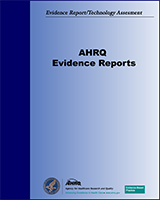NCBI Bookshelf. A service of the National Library of Medicine, National Institutes of Health.
Bravata DM, McDonald K, Owens DK, et al. Regionalization of Bioterrorism Preparedness and Response. Rockville (MD): Agency for Healthcare Research and Quality (US); 2004 Apr. (Evidence Reports/Technology Assessments, No. 96.)
This publication is provided for historical reference only and the information may be out of date.
The best we can do is to realize nobody can save his own skin alone. We must all hang together.
—Eleanor Roosevelt, April 5, 1938. 1 *
Background
The anthrax attacks of 2001, the severe acute respiratory syndrome (SARS) outbreak of 2003, and numerous weapons of mass destruction drills of the past few years have made it clear that no single community can prepare fully, nor respond completely, to a large-scale bioterrorism event. Policy makers, including elected officials, public health officials, emergency management professionals, clinicians, and leaders from the first responder communities, recognize the need to forge relationships and coordinate preparedness planning efforts at the local, state, national, and international levels.2 However, there is little consensus about the optimal level of localization or regionalization for each of the resources and services that must be operationalized during a bioterrorism response.
The Agency for Healthcare Research and Quality (AHRQ) determined that a comprehensive review of preparedness planning efforts, and response tasks and capabilities at local, state, national, and international levels could provide insights about ways to coordinate response efforts and maximize available resources for a bioterrorism response. The literature revealed widely disparate systems, reflecting the frequently individualized preparedness planning efforts of each group of response personnel (e.g., public health officials, clinicians, first responders, and emergency management professionals). There is little direct evidence as to whether regionalization either benefits or impairs bioterrorism preparedness planning or responses. Ongoing efforts to regionalize bioterrorism preparedness and response planning could be greatly advanced by rigorous evaluation and synthesis of the lessons learned from the 2001 anthrax response; ongoing bioterrorism surveillance efforts; regional responses to naturally occurring outbreaks and disasters; regional systems for the provision of specialty medical care, such as trauma care; and regionalization of the bioterrorism response supply chain.
The Purpose of the Evidence Report
The purpose of this Evidence Report is to evaluate the evidence regarding the effectiveness of existing regional systems that facilitate a response to bioterrorism. Because of the limited evidence about regionalized systems specific to bioterrorism preparedness and response, we evaluated evidence from relevant bioterrorism-related fields that bear on the question of whether regionalization of goods and services is likely to benefit a bioterrorism response. Specifically, we searched four primary sources: the medical, supply chain, and emergency management literatures and government documents. From these sources we sought three types of articles: those describing agencies with regionalized organizational structures that would likely contribute to a bioterrorism response, those describing bioterrorism-related events such as infectious disease outbreaks resulting from bioterrorism and natural causes and disasters, and those describing tasks routinely performed during a bioterrorism response such as triage, provision of emergency medical care, transportation, and surveillance. We analyzed the included articles for evidence that regionalization either benefited or impaired responders' performance of key tasks and whether it effected a more rapid delivery of the resources essential to performing these tasks.
The dearth of evidence regarding regionalization of two key tasks, bioterrorism surveillance and the timely delivery of pharmaceuticals and medical supplies to local dispensing sites, prompted us to develop simulation models of regionalization of these tasks. In our surveillance simulation, we explored the tradeoffs in sensitivity and specificity when the analysis of surveillance data includes pooling of data over a region. In our simulation of regionalization of stockpiles of pharmaceuticals, we investigated the costs and benefits of various strategies of maintaining local as opposed to regional inventories of antibiotics for a large-scale anthrax attack.
Footnotes
- *
Throughout this Report, the references referred to in the text can be found on pages 113 to 142 in the section entitled References and Included Studies. Note that pages 143 to 166 contain a Listing of Excluded Studies, not references.
- Introduction - Regionalization of Bioterrorism Preparedness and ResponseIntroduction - Regionalization of Bioterrorism Preparedness and Response
- Methods - Regionalization of Bioterrorism Preparedness and ResponseMethods - Regionalization of Bioterrorism Preparedness and Response
- Mus musculus solute carrier family 25 (mitochondrial carrier, adenine nucleotide...Mus musculus solute carrier family 25 (mitochondrial carrier, adenine nucleotide translocator), member 4 (Slc25a4), mRNAgi|1371545343|ref|NM_007450.5|Nucleotide
- Phtheirichthys lineatus voucher USNM:447055 cytochrome oxidase subunit 1 (COI) g...Phtheirichthys lineatus voucher USNM:447055 cytochrome oxidase subunit 1 (COI) gene, partial cds; mitochondrialgi|2037388471|gnl|uoguelph|HWBW065- I-5P|gb|MN549768.1|Nucleotide
- putative glucose-6-phosphate 1-epimerase [Brassica rapa]putative glucose-6-phosphate 1-epimerase [Brassica rapa]gi|685260393|ref|XP_009139679.1|Protein
Your browsing activity is empty.
Activity recording is turned off.
See more...
